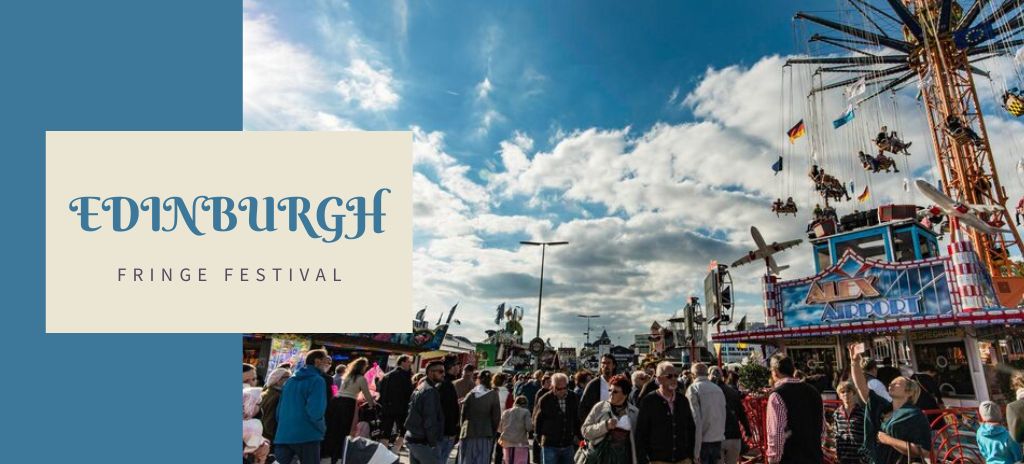The Edinburgh Fringe Festival is the largest arts festival in the world, held every August in Edinburgh, Scotland, transforming the city into a global stage for performance and cultural expression. For three weeks, Edinburgh becomes a vibrant tapestry of theater, comedy, dance, music, street performance, circus, cabaret, spoken word, and more, drawing artists and audiences from every corner of the globe.
History and Origins
The Fringe’s story started in 1947. In the aftermath of World War II, Edinburgh launched the Edinburgh International Festival to rejuvenate cultural life in Europe. However, eight theater groups, uninvited to the official program, arrived and staged their shows on the periphery of the main event, effectively performing “on the fringe.” This creative disruption laid the foundation for what would become the Edinburgh Festival Fringe. The festival quickly grew, and in 1958, the Festival Fringe Society was formed to coordinate its increasingly expansive program.
Key features of the early Fringe included the lack of a selection committee—meaning anyone with a venue could put on a show—and the use of unconventional spaces, from basements and pubs to parks and streets. This spirit of openness and innovation continues to define the festival today.
The Modern Fringe: A City Transformed
Every August, Edinburgh’s population triples as thousands of performers and visitors flood the city. The historic streets, especially the Royal Mile in Edinburgh’s Old Town, buzz with activity: street performers stilt-walk, juggle, or perform impromptu acts, university theatre groups hand out flyers; and musicians fill the air with sound. The festival is a true assault on the senses—in the best possible way.
The numbers are staggering. In 2024, the Fringe featured over 3,700 shows and more than 51,000 performances, and audiences purchased over 2.6 million tickets. Events are staged in over 260 venues, from grand concert halls and historic theaters to tiny pubs and pop-up stages. Comedy is the largest segment, making up nearly 40% of the program, but every conceivable genre is represented, ensuring there’s something for everyone.
Must-See Experiences
-
The Royal Mile: The epicenter of street performance and the best place to encounter the festival’s energy up close.
-
Hidden Gems: Beyond the headline acts, many of the most memorable experiences are found off the beaten path—look out for unknown artists, experimental theater, or small productions in unexpected locations.
-
Scottish Showcases: Initiatives like “Made in Scotland” support local artists, adding a uniquely Scottish flavour to the festival’s international lineup.
-
Food & Drink: Edinburgh offers a thriving food scene during the Fringe, from traditional Scottish fare to international street food.
Insider Tips for Attending
-
Plan but Stay Flexible: With 300+ pages of event listings, it’s impossible to see everything. Make a shortlist, book key shows early, but leave time to explore spontaneously.
-
Embrace the Unexpected: Some of the best moments happen when you take a flyer from a stranger and discover something new, or find yourself immersed in a small experimental show.
-
Book Accommodation Early: The city gets full fast—securing your lodging well in advance is essential.
-
Getting Around: Edinburgh is compact and walkable, but the festival crowds can be dense, so allow extra time to get from place to place.
-
Budget Wisely: While some events are free or low-cost, ticket prices vary. Prioritize some must-sees, but take advantage of free street performances too.
-
Pace Yourself: With so much to do, fatigue can set in. Schedule downtime to relax in one of Edinburgh’s parks or cafes.
The Fringe’s Impact and Legacy
The open-access ethos, allowing anyone to perform without a selection committee, has encouraged creative risk-taking, artistic freedom, and cultural exchange. The Fringe has helped launch the careers of famous comedians and writers, challenged norms, and promoted debate and experimentation. Its growth has inspired hundreds of similar “fringe” festivals around the world.
For Edinburgh itself, the Fringe is both a celebration and an economic powerhouse, bringing in significant tourism revenue and placing the city firmly at the heart of the UK’s cultural calendar. The festival also binds together city residents, artists, and visitors in a shared experience of discovery and creativity.
The 2025 Fringe: Dates and Outlook
In 2025, the Edinburgh Festival Fringe will run from 1 to 25 August. Artists and audiences are already preparing for another extraordinary celebration of the performing arts, with the city bursting at the seams once more with ideas, innovation, and unrepeatable moments.
Final Thoughts—Why the Fringe Matters
The Edinburgh Festival Fringe is more than just performances; it’s a celebration of expression, diversity, and the enduring power of the arts to bring people together. Its legacy is not only the acts on stage but also the transformative atmosphere it creates—one of inclusivity, experimentation, and joy. Whether you’re a first-timer or a seasoned visitor, the Fringe offers endless opportunities to experience something new, challenge your perceptions, and become part of a truly unique cultural phenomenon.
For anyone in the UK—and well beyond—it’s a must-do summer experience and a tribute to creativity in its rawest, most exhilarating form.








